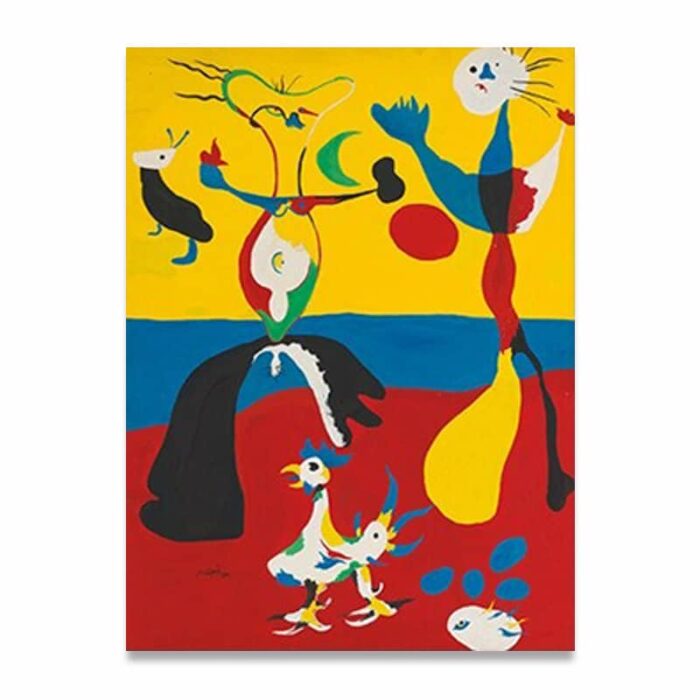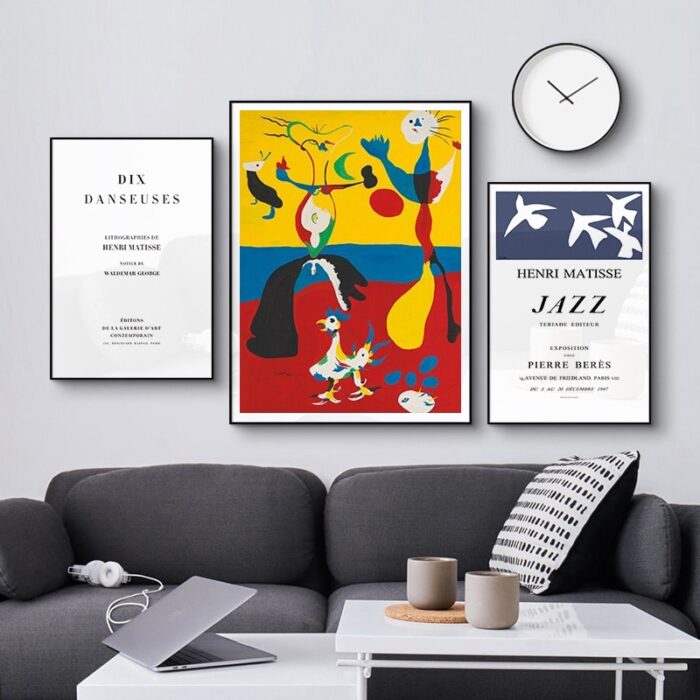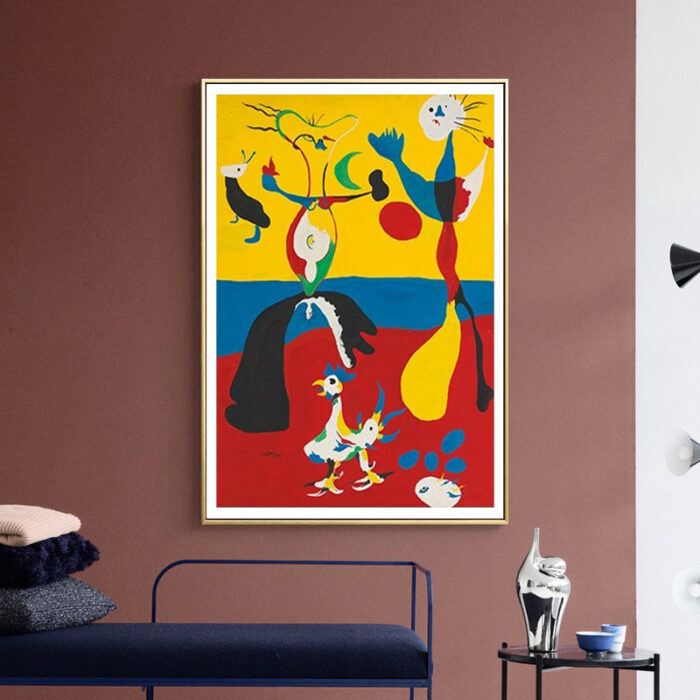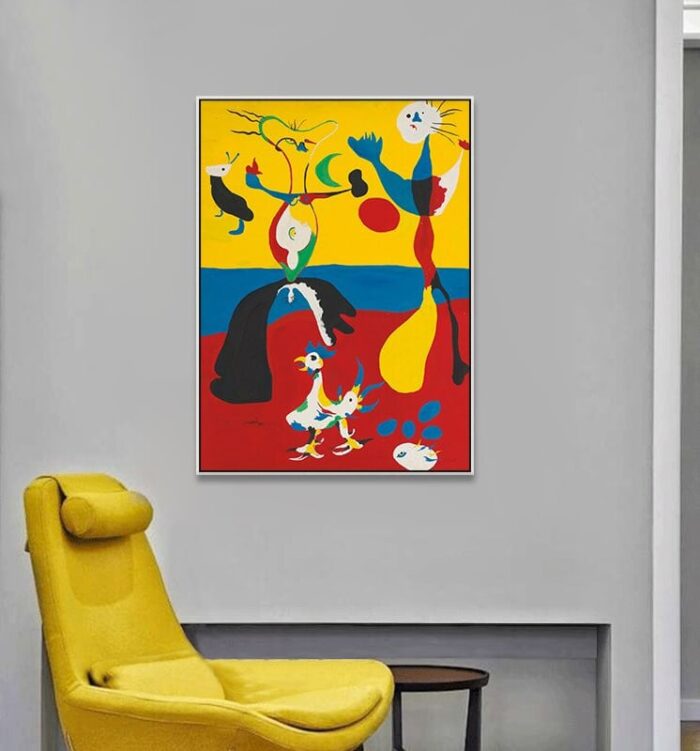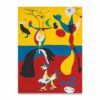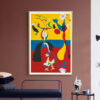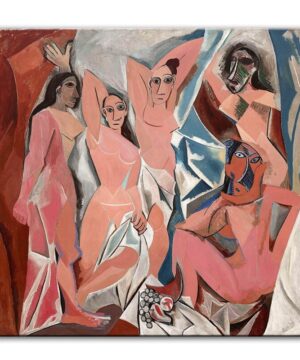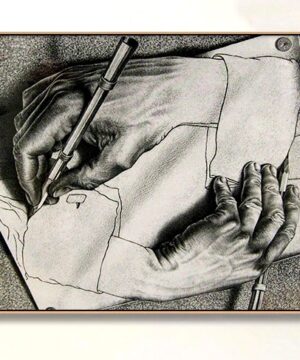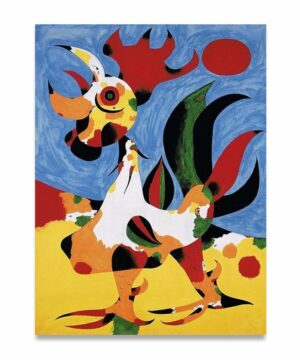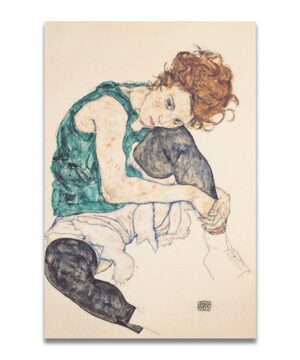Where is the picture “Le Fermier et son épouse” today?
The Joan MiróSpanish Catalan artist Joan Miró (1893 – 1983) is famous for his works in painting, sculpture, and ceramics. His work is strongly influenced by his hometown Barcelona, the scenic seaside, and the distinct style of that area. From early on, he was exposed to the arts through his parents’ professions: His mother was a goldsmith, father worked as a watchmaker. More original of “Le Fermier et son épouse” (1936) is currently part of a private collection in New York.What’s in it?
In “Le Fermier et son épouse” Miró depicts a Catalan farmer and his wife among farm animals in the landscape of Mont-Roig del Camp. Unlike previous works devoted to the farm, the artist abandons earthy hues and half-tones and in favour of bright primary colours, building strong contrasts between the yellow sky, the searing reds of the soil against the cool blues of the sea in the background, contrasting with deep blacks and imbuing the picture with a sense of heat. The simplified object structures seem inflated at some points and reduced to lines at others. The farmer on the left encompasses both massively enlarged limbs, while other body parts are transparent and merely outlined with strokes of colour, letting the blinding yellow sky break through. The yellow of the sky is repeated in the woman’s magnified right leg, balancing the colour scheme of the composition. In the foreground, a rooster aggressively protects an egg, which is on the verge of hatching. Miró used the image of the rooster in many pictures as a symbol of strength and would later make it the sole subject of a painting.What’s the context?
While Joan MiróSpanish Catalan artist Joan Miró (1893 – 1983) is famous for his works in painting, sculpture, and ceramics. His work is strongly influenced by his hometown Barcelona, the scenic seaside, and the distinct style of that area. From early on, he was exposed to the arts through his parents’ professions: His mother was a goldsmith, father worked as a watchmaker. More neither positioned himself as an explicitly political artist nor did he work exclusively formalistically with pure colours and forms, turning a blind eye to developments in society. He considered himself a man of freedom and liberalism. The movement for Catalan independence, the Civil War, the Franco dictatorship, as well as the Second World War strongly influenced his work. In the turbulent times of the lead-up to the outbreak of the Civil War in 1936, the artist was at Mont-Roig del Camp, where his family owned a farm. He revisited one of his early key works showing the farm painted in a surreal style, moving closer to abstraction. Before confrontations began between the putschists surrounding General Franco and the elected Popular Front government in October 1936, Miró fled to France. From there he supported the Republican fighters through his art. He produced a print titled “Aidez l’Espagne” – Help Spain – in 1937.Chatter and Prattle
Joan MiróSpanish Catalan artist Joan Miró (1893 – 1983) is famous for his works in painting, sculpture, and ceramics. His work is strongly influenced by his hometown Barcelona, the scenic seaside, and the distinct style of that area. From early on, he was exposed to the arts through his parents’ professions: His mother was a goldsmith, father worked as a watchmaker. More – Facts:- Miró’s love for the countryside dates to 1911 when his father purchased the farmhouse at Mont-Roig del Camp that was to play such an important role in his subsequent life and work.
- Miró’s parents originally wanted him to pursue a career in finance. He spent three years studying at a business school and then secured a job as an accounting clerk. However, Miró did not react well to the office tasks and the working environment, leading to what was referred to as a mental breakdown. Subsequently, Miró contracted typhoid fever and his parents took care of him in the family’s summer home in Mont-Roig del Camp. While recovering, Miró had the time to pursue his passion for paintingPainting is a fundamental form of visual art that has been practiced for thousands of years. It involves applying pigment to a surface such as canvas, paper, or a wall. Painting can be explored through various styles, techniques, and mediums, each offering unique possibilities for expression and creativity. Historical Background • Ancient Beginnings: The history of painting dates back to More and was later allowed by his parents to enrol in art school.
Joan Miró: Surrealism Through the Eyes of an Abstract Genius
76 Innovative Surrealism Art Ideas to Unleash Your Creative UnconsciousGuillaume Apollinaire, Surrealism and Today’s AI: Above RealityFacts to Know about Surrealism: Changing the Course of Art HistoryFamous Abstract Paintings: Joan Miró Art Works You Must Know10 World Famous Paintings of the Modern Period that changed the Artworld foreverHand with Reflecting Sphere by M. C. Escher – Canvas Giclée Print Further Recommended Readings:This article may contain compensated links. Please read Disclaimer for more info. As an Amazon Associate, I earn from qualifying purchases.Joan Miro et al. (2017): Joan Miro: I Work Like a Gardener (Interview with Joan Miro on his creative process)Carolyn Lanchner (1993): Joan Miro (A Museum of Modern Art Book)Agnes De La Beaumelle (2020): Joan Miró 1917–1934: I’m Going to Smash their GuitarMargit Rowell et al. (2017): Miro and Calder’s ConstellationsMarko Daniel et al. (2012): Joan Miro: The Ladder of Escape
